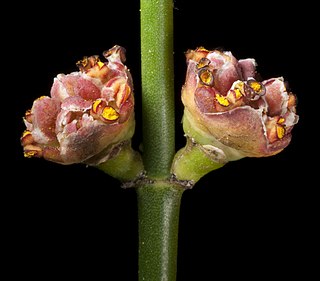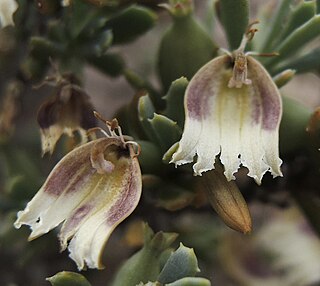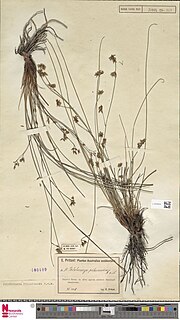
Calycopeplus is a plant genus of the family Euphorbiaceae first described by Jules Émile Planchon as a genus in 1861. The entire genus is endemic to Australia. Its closest relative is Neoguillauminia from New Caledonia.

Hakea salicifolia commonly known as the willow-leaved hakea, is species of flowering plant that is endemic to eastern Australia. It is an adaptable, fast growing small tree or shrub with attractive foliage and cream white flowers.

Aegiceras is a genus of trees and shrubs from Southeast Asia, Malesia, Australia and the Pacific Island,. and in Australia, in the Northern Territory, Queensland, New South Wales, and Western Australia. They occur as mangroves in coastal or estuarine areas.

Hakea decurrens, commonly known as bushy needlewood, is a species of shrub or small tree in the family Proteaceae.
Hollandaea sayeriana, sometimes named Sayer's silky oak, is a small species of Australian rainforest trees in the plant family Proteaceae.

Hakea aenigma, commonly known as the enigma hakea, is a shrub in the family Proteaceae native to South Australia. Only one of two Hakea species totally reliant on suckering to reproduce therefore have "reached evolutionary dead-ends".

Hakea pedunculata is a shrub or small tree in the family Proteaceae comprising approximately 150 species restricted to Australia. This species is found in the Far North region of Queensland and adjacent islands. It has flat, broadly egg-shaped leaves and white, cream or greenish flowers.

Nymphoides crenata, commonly known as wavy marshwort, is an aquatic perennial herb of the family Menyanthaceae endemic to Australia, found in all mainland states and the Northern Territory

Sclerolaena bicornis, commonly known as goathead burr, is a perennial shrub in the Amaranthaceae family, native to inland Australia, and found in Queensland, the Northern Territory, South Australia, New South Wales, and Western Australia

Scaevola collaris is a shrub in the family Goodeniaceae and its native range is five mainland states/territories of Australia: the Northern Territory, New South Wales, South Australia, Queensland and Western Australia.

Rumex vesicarius, also known as Ruby dock, or bladder dock, is a species of perennial flowering plant in the family Polygonaceae. According to Plants of the World Online, Rumex vesicarius is native to tropical and temperate Asia, Africa, and Western Australia. However, the Council of Heads of Australasian Herbaria asserts that within Australia it is naturalised in Western Australia, the Northern Territory, South Australia, Queensland and New South Wales.

Waltheria virgata is a species of flowering plant in the mallow family, Malvaceae, that is found in the north of Western Australia, and in the Northern Territory.

Fimbristylis velata is a species of sedge native to the North Island of New Zealand and Australia, where it is found in Western Australia, New South Wales, the Northern Territory, Queensland, Victoria, and South Australia.

Podolepis canescens is a herb in the Asteraceae family, which is found in South Australia, the Northern Territory, New South Wales and Victoria. PlantNet also states that it is found in Western Australia, but FloraBase states that the name is misapplied in Western Australia, based on Jeanes (2015).

Stenopetalum is a genus in the Brassicaceae family which is endemic to Australia. It was first described by Robert Brown in 1821.

Tribulus occidentalis, common name perennial caltrop, is a species of flowering plant in the family Zygophyllaceae, which is native to Australia, and found in Western Australia, Queensland, South Australia and the Northern Territory.

Phlebocarya pilosissima is a plant in the Haemodoraceae family, native to Western Australia.

Peplidium is a genus of flowering plants belonging to the family Phrymaceae. Its native range is Egypt to Sinai, Indian subcontinent, and Australia.

Portulaca filsonii is a plant in the Portulacaceae family, endemic to central Australia in the Northern Territory.

Tremulina tremula is a plant in the Restionaceae family, found in the south-west of Western Australia.



















